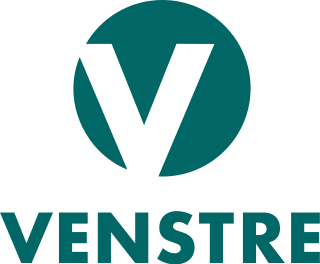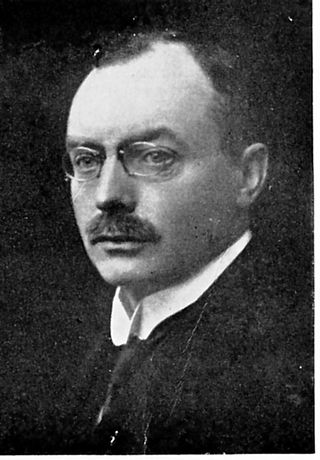This article gives an overview of liberalism in Norway. It is limited to liberal parties with substantial support, mainly proved by having been represented in the Norwegian Parliament, Stortinget.

Wollert Konow was the prime minister of Norway from 1910 to 1912. He was the leader of a coalition cabinet. Konow's time as prime minister saw the extension of accident insurance to seamen in 1911.
The Conservative Party or The Right is a liberal-conservative political party in Norway. It is the major party of the Norwegian centre-right, and was the leading party in government as part of the Solberg cabinet from 2013 to 2021. The current party leader is former Prime Minister Erna Solberg. The party is a member of the International Democracy Union and an associate member of the European People's Party.

The Liberal Party is a social liberal political party in Norway. It was founded in 1884 and is the oldest political party in Norway. Despite its native name, the Liberal Party is positioned in the centre on the political spectrum, and usually cooperates much more with the right wing parties. It is a liberal party which has over the time enacted reforms such as parliamentarism, freedom of religion, universal suffrage, and state schooling.

Fredrik Ludvig Konow was a Norwegian businessman and a politician for the Free-minded Liberal Party.
The Moderate Liberal Party was a political party in Norway that emerged from the moderate and religious branches of the Liberal Party in 1888. The party's turn towards cooperation with the Conservative Party caused a party split in 1891, eventually sharpening its profile as a moderate-conservative party based among the low church of south-western Norway. The party was dissolved shortly after the dissolution of the union with Sweden in 1905.
The Coalition Party was a Norwegian political coalition drawn from the Conservative Party, the Moderate Liberal Party and independent Liberals. Its main issues were opposition to the Liberal Party's political union radicalism, as well as to the rising growth of social democracy. Originally formed to pursue a more careful negotiating line towards Sweden, the party turned around and took part in Michelsen's Cabinet, which carried through the dissolution of the union between Norway and Sweden in 1905. The coalition's leading members included Christian Michelsen himself, Wollert Konow (SB) and Bjørnstjerne Bjørnson.
The Market towns of Nordland, Troms and Finnmark was an electoral district for parliamentary elections in Norway. It comprised the market towns of Bodø and Narvik in Nordland county, Tromsø in Troms county and Hammerfest, Vadsø and Vardø in Finnmark county.
The Market towns of Østfold and Akershus counties was an electoral district for parliamentary elections in Norway. It comprised the market towns of Fredrikstad, Halden, Moss and Sarpsborg in Østfold county and Drøbak in Akershus county.
The Market towns of Sør-Trøndelag and Nord-Trøndelag counties was an electoral district for parliamentary elections in Norway. It comprised the market towns of Trondheim in Sør-Trøndelag county and Levanger in Nord-Trøndelag county.
The Market towns of Vest-Agder and Rogaland counties was an electoral district for parliamentary elections in Norway. It comprised the market towns of Flekkefjord, Kristiansand and Mandal in Vest-Agder county and Haugesund and Stavanger in Rogaland county.
The Market towns of Telemark and Aust-Agder counties was an electoral district for parliamentary elections in Norway. It comprised the market towns of Brevik, Kragerø, Notodden, Porsgrunn and Skien in Telemark county and Arendal, Grimstad and Risør in Aust-Agder county.
The Market towns of Buskerud county was an electoral district for parliamentary elections in Norway. It comprised the market towns of Drammen, Hønefoss and Kongsberg in Buskerud county.
The Market towns of Vestfold county was an electoral district for parliamentary elections in Norway. It comprised the market towns of Holmestrand, Horten, Tønsberg, Sandefjord and Larvik in Vestfold county.
The Market towns of Møre og Romsdal county was an electoral district for parliamentary elections in Norway. It comprised the market towns of Kristiansund, Molde and Ålesund in Møre og Romsdal county.
Andreas Johannesen Hemma was a Norwegian farmer and politician.

Parliamentary elections were held in Norway on 11 September 2017 to elect all 169 members of the unicameral Norwegian Parliament, the Storting. The non-socialist parties retained a reduced majority of 88 seats, allowing Prime Minister Erna Solberg's Conservative-Progress coalition to remain in government. The Liberal Party joined the coalition in January 2018 but it remained a minority cabinet until the Christian Democratic Party joined the coalition in 2019. The three largest centre-left parties won 79 seats. The Green Party retained its single seat, while the Red Party won its first ever seat.




